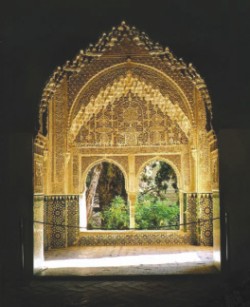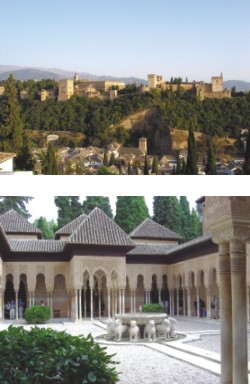|
A Roman Column
The Ledge of the Last Sigh
Neeman Sobhan
 |
Mexuar |
Three books spell for me some of the magic of Granada, which in a short trip was predominantly focused on the architectural gem, the palace and fortress complex of the last Muslim kings of 14th century Moorish Spain: the Alhambra.
I quote from the first book, constituting lines towards the end of a novel, where the fictitious hero, Moraes Zogoiby, called the 'Moor', is writing his story's end:
'……And so I sit here in the last light, upon this stone, among these olive-trees, gazing out across a valley towards a distant hill; and there it stands, the glory of the Moors, their triumphant masterpiece and their last redoubt. The Alhambra, Europe's red fort, sister to Delhi's and Agra's -- the palace of interlocking forms and secret wisdom, of pleasure courts and water-gardens, that monument to a last possibility that nevertheless has gone on standing, long after its conquerors have fallen………..'
The above is from one of my least favourite amongst Rushdie's oeuvres, 'The Moor's Last Sigh,' and yet, this passage cast such a beguiling light upon a famous historical pile that I too, desired to stand one day at that ledge to view what had inspired that ultimate sigh.
And so on a mid-afternoon we arrived by train from Cordoba, pulling into the railway station of Granada, the city named after the Spanish word for pomegranate. Our taxi left the city center below as it climbed up a steep and winding road to the 'Alhambra Palace Hotel' stunningly situated on top of a wooded hill with a view of the snow capped Sierra Nevada across the terraces, and in the vague distance, the fortified palaces of the Alhambra.
The next day, our guided tour of the Alhambra was scheduled for the afternoon, so we spent the morning taking a bus around the hilly Arab quarters of the Albaicin neighbourhood, which, including the Alhambra, is a UNESCO World Heritage site. Today, Albaicin is a popular district, just as during the Islamic period it was an important centre of the city.
We got off here and walking up some steep alleys, came upon a high terrace-like clearing. A guitarist was sitting on the low ledge tuning his instrument and warming his voice. We stood around, lulled by the melody and the mild sun and looked across the wooded valley to the spur of the hill, where a fortress stretched. As the strings of the guitar jangled and the sonorous voice of the singer filled the square like a sigh, I knew where we were.
I knew this spot because of another book on my shelf back home. An amusing volume of history trivia, with 365 factual events for every day of the year. The book starts with the First of January, 1660, and the very first entry of Samuel Pepy's diary. But the Second of January, 1492 is entered thus:
'….Boabdil, the ruler of Granada….handed the keys to the city to King Ferdinand of Aragon after a virtually bloodless siege that had lasted nine months. So on this day over five centuries ago the last Moorish stronghold in Spain surrendered to the crusading Catholic monarchs, Ferdinand and Isabella. The Moors, who had arrived in Spain almost 800 years earlier in 711, were finally defeated.
Mortified by his capitulation, Boabdil rode out through the gates of the city with his entourage, never to return. Reaching a lofty spur of the Alpujarras, he stopped to gaze back at the fabulous city he had lost. …The rocky ridge from which Boabdil had his last look at Granada has henceforth been called El Ultimo Suspiro del Moro (The Last sigh of the Moor).'
After lunch, we started for our guided tour of the Alhambra. As we entered the Nasrite palace and walked through the various courtyards and halls, I was struck by the sheer elegance of its decoration, exquisite but never gaudy. Walls and ceilings were covered richly in filigree plasterwork and lacy, glazed tile frieze in warm peach and beige tones. The complexity of the patterns in tile and latticework seemed at first sight to be repeated motifs in floral and geometrics but on close inspection revealed itself to include calligraphic texts, religious or poetic, intricately carved in repetitive symmetry. In a daze, I looked up at the exquisitely detailed arabesques of domes and arches, letting my tour-guide earphones hang idle like a modernist necklace.
 |
Top: View of Alhambra from Albiacin. Bottom: Courtyard of lions. |
The use of water as an element of architectural ornamentation was visually soothing and effective: internal pools mirroring the sky; doubling colonnades; elongating a patio; spreading a rippling carpet of coolness; and creating the hushed music of fountains.
The courtyard of the Lions and the Patio of Myrtles or some of the inner rooms and balconies with glazed ceramic and coloured glass made me sit down for a while.
The book I leafed through then was a copy of Washington Irving's, 'Tales of the Alhambra.'
Irving, the American writer of early 19th century, famous for his stories 'Rip Van Winkle' and 'The Legend of Sleepy Hollow' had come to Spain and lived in some of the rooms inside the Alhambra at a time when the palace was in a state of abandonment and neglect, inhabited by gypsies, shepherds and bandits. He was one of the main advocates for the conservation of the Alhambra's Nasrite palaces.
About the Moorish kings whom he admired he wrote: ' As I sat watching the effect of the declining daylight upon this Moorish pile…I fell into a course of musing upon the singular fortunes of the Morisco-Spaniards…As conquerors their heroism was only equaled by their moderation…Laying the foundation of their power in a system of wise and equitable laws, diligently cultivating the arts and sciences, and promoting agriculture, manufactures, and commerce, they gradually formed an empire unrivalled in prosperity by any of the empires of Christendom; and drawing round them the graces and refinements which marked the Arabian empire in the East, at the time of its greatest civilization, they diffused the light of Oriental knowledge through the western regions of benighted Europe.
The cities of Arabian Spain became the resort of Christian artisans, to instruct themselves in the useful arts. The universities of Toledo, Cordova, Seville, and Granada were sought by the pale student from other lands to acquaint himself with the sciences of the Arabs and the treasured lore of antiquity…'
And yet, Irving muses, 'Never was the annihilation of a people more complete than that of the Morisco-Spaniards…The home of their adoption…refuses to acknowledge them, except as invaders and usurpers. A few broken monuments are all that remain to bear witness to their power and dominion, as solitary rocks left far in the interior bear testimony to the extent of the vast inundation. Such is the Alhambra: an elegant memento of a brave, intelligent, and graceful people, who conquered, ruled, flourished, and passed away.'
But did they just pass away or did they leave behind a message? I go back to a luminous and enchanted palace on a hill, whose original builders, the Moorish conquerors are gone, as are the Christian kings who re-conquered it. Gone also are those who let the palace fall to ruin, and gone too, are those who restored it. Gone are those who inhabited it for a while, and gone are those who had to leave, turning back for a last look. So, what remained in the end? A silent tomb of beauty, beyond owning, beyond conquest, something to be enjoyed and shared by all. Perhaps the Moors intend us to discover that temporal notions of conquest and defeat, ownership and losing claim, are not worth the pain? In the invisible world of permanence, victory lies beyond defeat.
The engraved tiles and borders of Kufic and cursive script above the arched doorways and windows spell over and over a single phrase: 'Wa La Ghalib illa Allah.'
The visual echo as it bounces off the filigree walls sighs: There is no Victor but God.
Copyright
(R) thedailystar.net 2010
|

